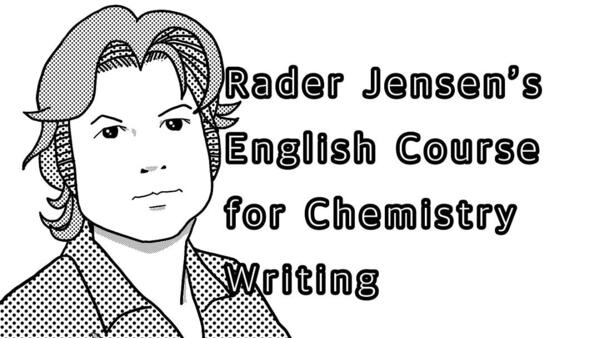CSJ Journals
[化学論文のための英語講座] 第53回:冠詞 Part2
(English version is here.)
冠詞の役割を感覚的に理解するために、以下の6つの分類を用いて簡単な例文を見てみましょう。話し言葉で見るとわかりやすいと思います。
| Countable | definite | singular | the | (1) |
| definite | plural | the | (2) | |
| indefinite | singular | a, an | (3) | |
| indefinite | plural | no article | (4) | |
| Uncountable | definite | - | the | (5) |
| indefinite | - | no article | (6) |
A: Do we have ether?
訳文:エーテルはありますか?
解説:これは非限定で数えられない名詞についての質問ですので、分類(6)です。直訳すると「私たちはエーテルを持っていますか?」という意味になります。無水エーテルか、昨日買ったエーテルか、蒸留したエーテルかは限定していません。
B: Yes, we have ether.
訳文:はい、エーテルはあります。
解説:これも分類(6)です。 どんなエーテルかは述べていませんが、あります。
A: Where is the ether?
訳文:エーテルはどこですか?
解説:the etherは分類(5)で、 限定しています。AとBは相互にどのエーテルかがわかっています。
B: The ether is in the solvent room.
訳文:エーテルは溶媒庫にあります。
解説:このthe etherも分類(5) です。エーテルはどれでも良いわけではなく、AとBが指定したエーテルです。更にA と B はどの溶媒庫かわかります。the solvent roomは、数えられる名詞の限定ですので分類(1) です。
A: Where do you keep sodium hydride?
訳文:水素化ナトリウムはどこに保管していますか?
解説:sodium hydrideは非限定の分類(6) です。水素化ナトリウムが実際に実験室にあるかどうかは別に関係ありませんが、あったらどこに保管するかを尋ねています。
B: We keep it in a desiccator.
訳文:デシケーターに保管します。
解説:a desiccatorは、数えられる名詞の非限定ですので分類(3) です。どのデシケーターかは述べていません。水素化ナトリウムが実際にあるかも述べません。
A: Did you return the sodium hydride to the desiccator?
訳文:水素化ナトリウムをデシケーターに戻しましたか?
解説:the sodium hydrideとthe desiccatorのどちらも限定です。なお水素化ナトリウムは数えられない名詞ですので分類(5)で、デシケーターは数えられる名詞で分類(1)です。どの水素化ナトリウム、どのデシケーターかはAとBは相互にわかりますので「the」を利用します。
B: Yes, I returned it to the small desiccator.
訳文:はい、小さいデシケーターに戻しました。
解説:the small desiccatorは分類(1) です。AとBが相互にわかる小さなデシケーターに戻しました。
他の言い方も見てみましょう。
(i)
A: Is there ether?
訳文:エーテルはありますか?
解説:etherは分類(6)になります。そのために非限定で、英語のこの質問は曖昧です。この質問を受けると、地球上さらには宇宙のどこかにあるかどうかを尋ねています。実験室にあるかどうかを尋ねる場合は、最初の例文 Do we have ether? の方が自然です。
B: Yes, why?
訳文:はい、なぜですか?
解説:聞き手はちょっと戸惑っています。確かにどこかには存在しています。
A: Where is it?
訳文:それはどこにありますか?
B: You need to order some. We have none in the lab.
訳文:注文しなければなりません。実験室にはありません。
解説:確かにエーテルはどこかにはありますが、実験室にはありません。the labは分類(1) です。
(ii)
A: Where is the graduated cylinder?
訳文:メスシリンダーはどこですか?
解説:分類(1)になるthe graduated cylinderを使っているので、話し手は(1) 限定されたメスシリンダーを考えています。
B: Which graduated cylinder?
訳文:どのメスシリンダーですか?
解説:先の質問に対して、聞き手はどのメスシリンダーなのか、わからないため、theをつけない表現をしています。
A: The 500 mL graduated cylinder.
訳文:500mL メスシリンダーです。
B: It is next to the sink.
訳文:流しの隣にあります。
次回は冠詞 Part3です。
In order to intuitively understand the function of articles, let us look at to the simple example sentences of the following six types. Conversational speech should be the easiest to understand.
| Countable | definite | singular | the | (1) |
| definite | plural | the | (2) | |
| indefinite | singular | a, an | (3) | |
| indefinite | plural | no article | (4) | |
| Uncountable | definite | - | the | (5) |
| indefinite | - | no article | (6) |
A: Do we have ether?
Explanation: This question contains an indefinite, uncountable noun and thus follows (6). This is not limited to a particular variety of ether, for example, anhydrous ether, either purchased yesterday, or distilled ether.
B: Yes, we have ether.
Explanation: This also follows (6). The sort of ether is not specified, but it is in possession.
A: Where is the ether?
Explanation: This question follows (5), and thus is limited. Speakers A and B mutually understand which ether.
B: The ether is in the solvent room.
Explanation: The ether follows (5), meaning not just any ether, but rather ether that has been designated by A and B. Furthermore, A and B both know which solvent room. The solvent room is an uncountable, definite noun and thus follows (1).
A: Where do you keep sodium hydride?
Explanation: Sodium hydride follows (6) and thus is uncountable and indefinite. Whether sodium hydride is actually in the laboratory or not does not particularly matter. The sentence asks where sodium hydride would be stored if it were in possession.
B: We keep it in a desiccator.
Explanation: A desiccator follows (3) and thus is indefinite and countable. Which desiccator is not specified, nor is the actual presence of sodium hydride.
A: Did you return the sodium hydride to the desiccator?
Explanation: Both the sodium hydride and the desiccator are limited. Additionally, sodium hydride is an uncountable noun and follows (5), while desiccator is a countable noun and follows (1). Which sodium hydride and which desiccator are mutually understood by A and B, and thus the is used.
B: Yes, I returned it to the small desiccator.
Explanation: The small desiccator follows (1). It was returned to the mutually understood small desiccator.
Now let us examine another way of saying things.
(i)
A: Is there ether?
Explanation: Here, ether follows (6). Because of this, it is indefinite, and in English is a vague question. This question asks whether ether exists anywhere on earth or in space. When asking whether there is ether in the laboratory, the first example "Do we have ether?" is natural.
B: Yes, why?
Explanation: The listener is somewhat confused. Ether certainly exists somewhere.
A: Where is it?
B: You need to order some. We have none in the lab.
Explanation: Of course, ether exists somewhere, but not in the lab. The lab follows (1).
(ii)
A: Where is the graduated cylinder?
Explanation: The graduated cylinder follows (1) and thus, the speaker is thinking of a specific cylinder.
B: Which graduated cylinder?
Explanation: With respect to the previous question, the listener does not know which graduated cylinder, so the does not appear.
A: The 500 mL graduated cylinder.
Explanation: This cylinder is limited and mutually understood.
B: It is next to the sink.
Explanation. Sink is mutually understood.
At next time, we will discuss about Article 3.
